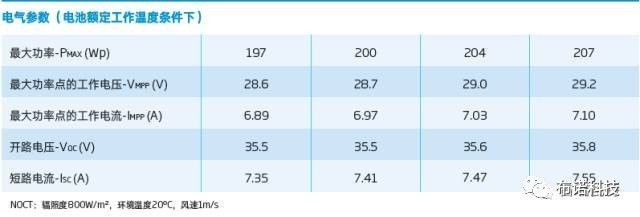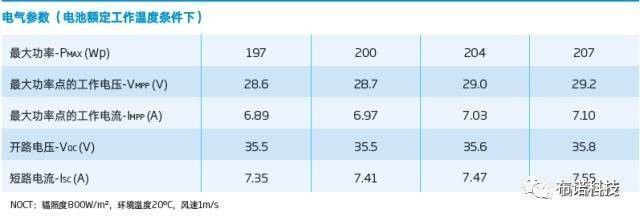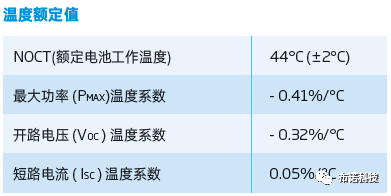
PV module is one of the most important equipment of photovoltaic power plant, the cost accounts for about 50% of the grid system, and the technical parameters of solar panel is very important for design the system, only know the parameters of solar panel, then can configure the correct inverter.
We always say 265Wp PV modules. The "p" in the following table is an abbreviation for peak, representing a peak power of 265W. All technical specifications will be marked "standard test conditions". "0 ~ + 5" represents the positive tolerance, 265W component power range between 265W to 270W for the qualified product, the following picture is part of the polycrystalline PV module technical specifications.

Only in the standard test conditions (irradiance of 1000W / m2, battery temperature 25 ℃), the PV module output power is "nominal power" (265W), irradiance and temperature changes, the power will certainly change. Under non-standard conditions, the output power of PV modules is generally not nominal power, as shown below.

In theory, the size, nominal power of the same components, the efficiency is certainly the same. The PV module is composed of a battery pack, usually composed of 60 (6 × 10) or 72 (6 × 12) cells, with an area of 1.638m2 (0.992m × 1.652m) and 1.94m2 (0.992m) × 1.956m).

When the irradiance is 1000W / m2, the power received on the 1.638m2 component is 1638W. When the output is 265W, the efficiency is 16.2% and 17% at 280W.
Voltage divided circuit voltage and MPPT voltage, temperature coefficient of sub-voltage temperature coefficient and power temperature coefficient. In the serial and parallel design, use the open circuit voltage, operating voltage, temperature coefficient, the local extreme temperature (preferably day) for the maximum open circuit voltage and MPPT voltage range calculation, and the inverter to match.

In addition to inverter and other equipment factors, solar radiation and temperature affect the output power of solar panel. Factors affecting the radiation as below:
The larger the solar height angle, the shorter the path through the atmosphere, the less the weakening effect of the atmosphere on the solar radiation, the stronger the solar radiation reaching the ground; the larger the solar height angel, the smaller the area of the solar radiation and the stronger the radiation. For example, the intensity of solar radiation at noon is stronger than earlier.
The higher the altitude the more thin the air, the weaker the effect of solar radiation, the stronger the solar radiation to reach the ground. For example, the Qinghai-Tibet Plateau is the strongest solar radiation area in China.
Sunny cloud less, the weakening effect of solar radiation, the stronger solar radiation to reach the ground. For example, the Si chuan Basin with cloudy rainy weather and solar radiation weakened, its solar radiation has become the lowest value of in China.
High atmospheric transparency is the weakening effect of solar radiation, which make solar radiation reach to the ground strong.
Pollution is heavy, the solar radiation weakened, solar radiation to reach the ground less , haze weather has big influence on the PV module.In like Baoding, Hebei foggy weather area , the annual power generation is less about 10% than the theory of one.
Maximum output power of pv module, regardless of the inverter and other equipment factors, is affected by the solar irradiance and temperature. The solar radiation limit is the solar constant, the value is 1368W / m2. After reaching the Earth's surface, affected by weather and other aspects, the maximum value is about 1200 W / m2, power temperature system of pv module becomes about -0.39% / ℃, pv temperature drop, and power of pv module will rise. One 250W pv module, in the absence of equipment loss, in the best areas of China's sunshine such as northern Ningxia, northern Gansu, southern Xinjiang and other regions, the maximum output power rise up to 300W.
In the configuration of the inverter, we should pay attention to two aspects:
1. The voltage of several pv module in series is the sum total of the voltage of each pv module. When the working voltage is about the rated working voltage of the inverter, the efficiency is the highest. Single phase 220V inverter, the rated input voltage is 380V. Three-phase 380V inverter, the rated input voltage is 650V.
For example 3KW inverter, with 260W pv module, working voltage 30.5V2, if so 12pieces working voltage 366V, total power 3.12KW is the best. 30KW inverter with 260W pv module, then 126 pieces pv module, 21 pieces as one string, the voltage is 640.5V, the total power of 32.76kW is the best.
2. After series connection, the maximum limit of the open circuit voltage can not exceed the maximum voltage of the inverter. For example, 270W pv module, open circuit voltage is 38.3V, open circuit voltage temperature coefficient is -0.32% / degrees, if the -25 degrees, 24 pieces pv module in series, open circuit voltage V = 38.3 [1 + (- 25-25) * (- 0.0032)] * 24 = 1066V finally.

In summary, when the system power in the inverter rated power between 40-60%, there is the highest efficiency and the longest service life. In order to optimize the performance of the inverter, according to different lighting conditions, pv module and inverters have different ratio.
In first category lighting areas, the average sunshine time of more than 5 hours, power generation time by 10 hours per day, the proposed pv module and inverter as 1: 1 configuration, the average power around 50%;
In second category light area, the average sunshine time of 4 hours, power generation time by 9 hours per day, the proposed pv module and inverter as 1.1: 1 configuration, (4 * 1.1) / 9, the average power around 49%;
In third category light area with 3.5 hours average sunshine time, the power generation time is 8.5 hours per day. It is recommended that pv module and inverter can be configured at 1.2: 1, (3.5 * 1.2) / 8.5, and the average power is about 49.4%. In the three category area with average sunshine time less than 3 hours, the power generation time calculated by 8 hours per day, the proposed pv module and inverter as 1.3: 1 configuration, (3 * 1.3) / 8, the average power is about 48.75%.
Due to orientation of the mountain power station is different and the complexity of the distributed pv roof, the PV module does not towards necessarily south and the roof tilt angle is not necessarily the best inclination. The configuration of the inverter can be handled flexibly according to the specific situation.